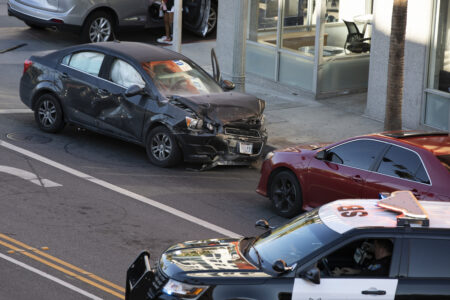
Share On Social!
Did you know guns and traffic crashes are the leading causes of death for youth ages 1-19?
These deaths are problematic and unacceptable for four key reasons:
- These child deaths are unnatural and violent.
- Child deaths from guns and traffic crashes have risen since 2013, with spikes in both in 2020.
- Traffic and firearm death rates among American youth are higher than other high-income countries.
- These violent deaths are preventable.
Traffic and gun violence are not criminal justice issues, they are public health issues.
Preventing violent child deaths from traffic crashes and firearms requires a comprehensive and multi-layered public health approach to:
- Define and monitor the problem
- Identify risk and protective factors
- Develop prevention strategies
- Ensure adoption of strategies
“The public health approach allows us to take a look at things and use the science we have that inform our actions,” said Dr. Michael Rodriquez, physician and professor at University of California, Los Angeles, and co-director of the university’s Firearm Violence Prevention Center, according to USA Today. “We have mechanisms to look at the products the consumers’ purchase and look at them in ways to reduce the danger that they present to the public.”
We at Salud America! are exploring a public health approach to violent child death in a four-part series.
1. The U.S. Has a Violent Child Death Problem
U.S. youth are increasingly killed in violent gun and traffic incidents.
About 12.5% more children younger than 16 were killed in traffic crashes in 2021 than 2019, according to the National Highway Traffic Safety Administration (NHTSA).
About 29.5% more children younger than 16 were killed by firearms in 2020 than 2019, according to a 2022 letter to the editor in the New England Journal of Medicine.
These rates are also far higher in the U.S. than other high-income countries.
America has higher rates of traffic death than Australia, Canada, Spain, and more.
No other high-income country has more child deaths caused by guns.
Gun violence negatively impacts education attainment, strains school and state budgets, reduces business growth, and slows housing price growth, according to a Joint Economic Committee report.
The problem of violent child death is clear – but the full scope of the issue is not.
We lack data on traffic and gun violence due to the lack of a public health approach to injury prevention and subsequent of lack of funding for injury prevention research.
We need a public health approach to prevent violent child deaths from firearms and motor vehicles.
This would fund more injury prevention research to better understand violent child death in America, identify risk factors, and craft strategies to prevent child deaths from traffic crashes and firearms.
Read more!
2. What Are the Risk and Protective Factors for Violent Child Death?
Neither traffic crashes nor gun violence are random.
Vehicle design, road design, and speeding are the most critical contributors to the recent spike in traffic deaths on American roads.
“Federal safety regulators have known for years that SUVs, with their higher front-end profile, are at least twice as likely as cars to kill the walkers, joggers and children they hit, yet have done little to reduce deaths or publicize the danger,” according to an investigative report by the Detroit Free Press and USA Today Network.
The failure to research and report on the growing size of vehicles and lack of vehicle regulation as a contributor to traffic deaths is not unique.
Similarly, U.S. leaders have failed to research and report on the increasing guns per capita and lack of gun regulation as a risk factor for gun deaths.
We know risk factors for firearm violence include access to/presence of guns in the home, individual history of violent victimization, community history of violence, community history of segregation and disinvestment, poverty, and strictness of state gun laws, such as the presence of Shoot First/Stand Your Ground laws and the absence of extreme risk protection laws.
However, we don’t know the most critical contributors to the recent spike in firearm deaths in America.
Violent child death and injury from motor vehicles and firearms are systemic problems that require a public health approach to systemic data collection to identify and reduce risk factors and to identify and promote/support/enhance protective factors.
Read more!
3. Developing and Advocating for Strategies to Prevent Violent Child Deaths
We need a public health approach to develop strategies to prevent violent child deaths from guns and traffic crashes.
But which strategies?
A combination of five frameworks could help.
Theory of Change Logic Model. Beyond a basic logic model, a theory of change logic model calls for consideration of bigger theoretical ideas to understand and explain how proposed strategies will produce expected outcomes.
This is a five-step process that requires identification of and discussion about:
- The root causes of the problem, to include the root causes of the risk factors rather than just the risk factors themselves
- Layering various prevention strategies (which will be discussed in following four frameworks)
- Where the proposed strategies fit into the vast sphere of numerous public policy, institutional, organizational, community, and individual factors that also impact the problem
- The potential barriers that stand in the way of prevention strategies
- The underlying values, beliefs, and assumptions regarding both the problem and the proposed strategies
The Swiss Cheese Risk Reduction. This framework offers a helpful visual depiction of how a variety of strategies are necessary to work together to prevent traffic deaths and firearm deaths.
Each strategy or intervention to address traffic deaths and firearm deaths has holes, like a slice of swiss cheese, for which risk can slip through. Multiple layers of strategies cover the holes in other strategies which reduces risk and increases protection.
Three levels of prevention strategies. This framework posits three levels of prevention strategies: primary, secondary, and tertiary.
Strategies span from systemic policy changes to tailored interventions to individual treatment plans. There is an emphasis on an upstream approach to addressing the root causes of the problems.
The Balanced Ladder of Intervention. Building on the most effective primary and secondary prevention strategies, this framework can facilitate conversations about the level of intrusiveness of each strategy to determine if they negatively interfere with freedom.
Racial Equity Assessment Tools. There are various racial equity tools available to support the systematic evaluation of how proposed or existing budgets, programs, policies, and procedures may impact different racial and ethnic groups.
The goal is to identify, eliminate, and prevent structural and institutional racism and minimize the negative impact on historically marginalized communities.
The combination of these four frameworks can support development of and advocacy for strategies to prevent violent child deaths and injuries, experts say.
4. Ensuring Adoption of Strategies to Prevent Violent Child Death
Beyond developing and advocating for strategies to prevent violent child death, we also need to ensure these strategies are implemented.
For example, our nation has recently made historic investment in transportation safety and gun safety. Advocates can help states adopt and implement these policies and programs.
In November 2021, President Joe Biden signed legislation doubling funding for transportation programs improve safety, and in June 2020, he signed the first major gun safety legislation passed by Congress in nearly 30 years.
To prevent violent child death and injury and to prevent inequities in violent child death and injury, we need to ensure the programs and policies in these bills are implemented.
Additionally, much more can be done beyond what is included in these bills.
Moreover, we need to invest more in public health and improve data collection to define and monitor the problem of violent child death and identify risk and protective factors.
Read more on Dec. 29, 2022!
By The Numbers
27
percent
of Latinos rely on public transit (compared to 14% of whites).



